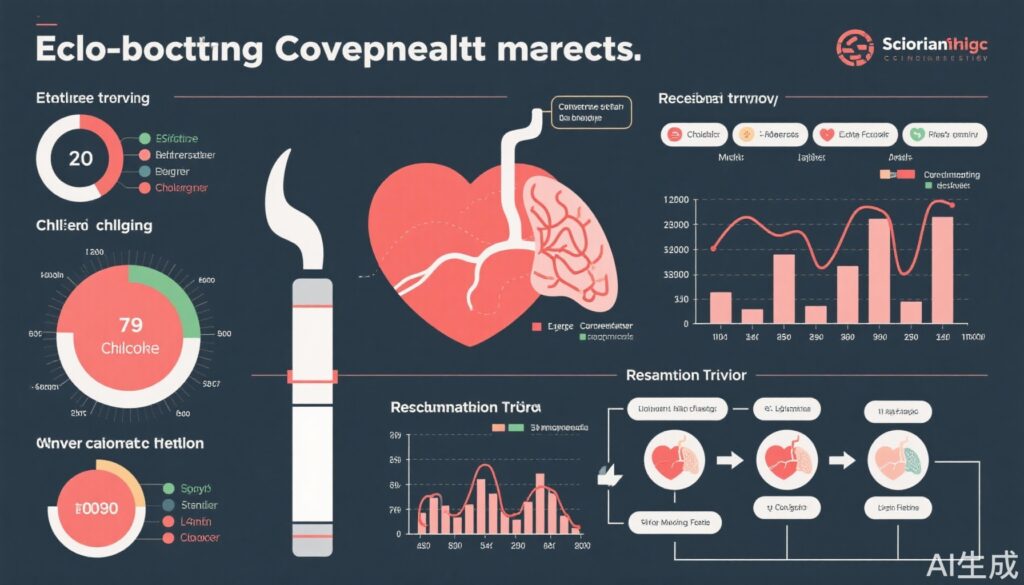Highlights
- Nicotine e-cigarettes with the highest nicotine concentration (36 mg/mL) modestly improve blood lipid profiles among smokers attempting reduction, notably increasing HDL and decreasing LDL levels.
- There are no significant differences in lung function indices or markers of systemic inflammation between e-cigarette users and cigarette substitute groups after 6 months.
- The trial highlights the need for further inclusion of cardiovascular biomarkers in smoking cessation research to better elucidate the long-term health impacts of e-cigarettes.
- Complementary studies affirm the potential of e-cigarettes as harm reduction tools, though cardiovascular and pulmonary safety profiles remain under active investigation.
Background
Tobacco smoking remains a leading modifiable risk factor for cardiovascular diseases (CVD) and respiratory illnesses worldwide. Although conventional smoking cessation aids exist, many smokers struggle to quit tobacco cigarettes. Electronic cigarettes (e-cigarettes), delivering nicotine without combustion, have emerged as potential harm reduction tools. Their effects on cardiovascular risk factors, lung function, and broader health outcomes compared to cigarette substitutes have been under-investigated, particularly in randomized controlled settings with longitudinal follow-up.
Key Content
Randomised Placebo-Controlled Trial Design and Population
Dahal et al. (2025) conducted a rigorous four-arm, parallel-group, double-blind randomized placebo-controlled trial at two U.S. academic centers involving 520 adults aged 21-65 who smoked ≥10 cigarettes daily and wished to reduce consumption. Participants were randomized to use e-cigarettes containing 0, 8, or 36 mg/mL nicotine or a non-aerosol cigarette substitute. The primary endpoint focused on changes in CVD risk markers, lung function, and clinical laboratory parameters over 6 months.
Findings on Cardiovascular Disease Risk Biomarkers
While most measures did not differ significantly across groups, those randomized to the highest nicotine e-cigarette dose (36 mg/mL) exhibited statistically significant improvements in lipid profiles compared to cigarette substitutes, including increased high-density lipoprotein (HDL) cholesterol and decreased low-density lipoprotein (LDL) cholesterol and cholesterol/HDL ratio. These findings persisted after adjustment for confounders, suggesting a modest cardioprotective biochemical profile in this subgroup.
Impact on Lung Function and Inflammatory Markers
No significant differences were observed between groups in spirometry indices or pulmonary symptomatology as measured by validated questionnaires. Likewise, blood C-reactive protein and other systemic inflammation markers remained unchanged, indicating no measurable lung function benefits or harms attributable to e-cigarette use within 6 months.
Complementary Evidence from Related Clinical Studies
Other randomized trials and observational studies corroborate these findings: e-cigarettes facilitate smoking reduction or cessation with neutrality or modest benefit for cardiovascular parameters such as blood pressure and endothelial function (e.g., Caponnetto et al., 2014; George et al., 2019). Acute studies reveal that nicotine inhalation via e-cigarettes elevates heart rate and arterial pressure transiently, comparable to smoking but may have less impact on vascular oxidative stress than tobacco cigarettes. Additionally, data among chronic disease populations (COPD, diabetes, CAD) support the feasibility and potential harm reduction of e-cigarettes, although long-term outcomes remain under evaluation.
Mechanistic Insights and Physiological Impact
Nicotine is known to modulate sympathetic nerve activity, increasing heart rate and blood pressure acutely. However, absence of combustion-related toxins in e-cigarettes likely reduces inflammatory and oxidative endothelial injury compared to tobacco cigarettes. This trial’s lipid modifications may reflect improved systemic physiology upon tobacco reduction via nicotine replacement.
Expert Commentary
This rigorously controlled trial importantly advances understanding by stratifying nicotine dose effects and including a placebo control arm—a methodological strength often lacking in e-cigarette research. The observed lipid profile improvements with high-nicotine e-cigarettes highlight potential cardiovascular benefit, yet the lack of lung function change tempers enthusiasm, emphasizing cautious interpretation. The study underscores the complexity of evaluating harm reduction tools where partial smoking substitution and dual use are common.
Current clinical guidelines, such as those by the American Heart Association and Public Health England, cautiously endorse e-cigarettes as an alternative for smokers unable to quit otherwise but advise ongoing monitoring for cardiovascular safety. The absence of adverse changes in systemic inflammation and lung function over 6 months in this study is reassuring but highlights the need for longer-term, larger-scale trials and inclusion of clinical cardiovascular event endpoints.
Limitations include the relatively short observation period, potential compensatory smoking behaviors, and study population limited to smokers interested in reduction rather than cessation per se. Diverse e-cigarette devices and liquids warrant further investigation to generalize findings.
Conclusions
Evidence from this randomized placebo-controlled trial shows that e-cigarettes with high nicotine concentration confer modest improvements in lipid cardiovascular risk markers without detrimental effects on lung function or systemic inflammation during cigarette reduction attempts. These findings support the hypothesis that nicotine e-cigarettes might play a role in reducing cigarette-related cardiovascular harm.
Future research should continue integrating cardiovascular biomarker assessments, extend follow-up duration, and explore mechanistic pathways to clarify long-term cardiovascular and respiratory health outcomes associated with e-cigarette use. This will inform clinical guidance and public health policy around tobacco harm reduction strategies.
References
- Dahal S, Yingst J, Wang X, et al. Changes in cardiovascular disease risk, lung function and other clinical health outcomes when people who smoke use e-cigarettes to reduce cigarette smoking: an exploratory analysis from a randomised placebo-controlled trial. BMJ Open. 2025;15(6):e098005. doi:10.1136/bmjopen-2024-098005. PMID: 40533223.
- Caponnetto P, Campagna D, Cibella F, et al. Efficiency and safety of an electronic cigarette (ECLAT) as tobacco cigarettes substitute: a prospective 12-month randomized control design study. PLoS One. 2014;9(6):e99312.
- George J, Hussain M, Vadiveloo T, et al. Cardiovascular Effects of Switching From Tobacco Cigarettes to Electronic Cigarettes. J Am Coll Cardiol. 2019;74(25):3112-3120. doi:10.1016/j.jacc.2019.09.067.
- Glantz SA, Bareham DW. E-Cigarettes: Use, Effects on Smoking, Risks, and Policy Implications. Annu Rev Public Health. 2018;39:215-235.



